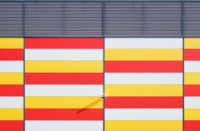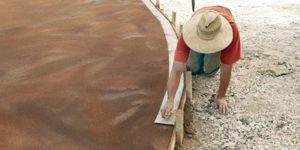Recently, Richard Morrison, plant manager at my company’s Houston, Texas, manufacturing facility, reminded me of the importance of remaining consistent with all of your raw materials for a decorative project.
He explained that he has seen an increase in complaints about the final color not matching the sample or mock-up that had been placed just a week or so earlier. Most of these were integral color jobs. In all cases, a small mock-up was created, finished and cured as specified, and eventually accepted by the client. Fast forward to the actual job placement, and all of a sudden the color no longer matched the mock-up sample.
After a little bit of investigation, it was discovered that the contractor had used store-bought bagged concrete to create the mock-up, but the actual job was placed using standard ready-mix concrete.
When this was brought to the attention of the contractors, the response was always the same. “I didn’t want to pay for a yard or more of concrete for a 4-square-foot sample, and besides, it’s all gray concrete, what’s the big deal?” Well, not only is it a big deal, it is a huge deal! When you consider that everything going into a concrete mix has an impact on the final color, and Rule No. 1 for integrally colored concrete is batch-to-batch consistency, it only stands to reason that switching base concrete between the sample and the pour is going to have a big impact on the final color.
I know what you are saying, and I agree that it is expensive to pay for 1 to 3 yards (the typical minimum for colored concrete depending on region) for a mock-up. However, when you consider the cost of labor and materials to correct a color issue, or worse yet, a complete rip-out and replace, a few yards of concrete start to look cheap.
Some contractors I have worked with will add the cost of the ready-mixed concrete for mock-ups and samples right into their invoice as a separate line item. This typically works on large commercial jobs or custom color jobs but may not go over in a residential or small project setting. In those instances I have seen contractors charge for one initial sample produced from the same ready-mix supplier that will be used on the job. If the client approves the sample and hires the contractor for the job, the fee is waived. If the contractor is not hired after producing the sample, the client is charged. There is also a charge if additional samples are required.
In general, most savvy contractors will build the cost for the yard or more of concrete used in the mock-up right into the final price to avoid any out-of-pocket cost.
Why is consistency important?
So now that we have addressed how to offset the cost of using the same material for mock-ups and the actual pour, let’s look at why it is so important to stay consistent.
First, the rule of batch-to-batch consistency from sampling to actual project extends beyond integrally colored concrete. The same philosophy holds true for any decorative concrete application. When doing samples, you need to use the same base materials or work on the same substrate (especially when working with stains and dyes) that will be used in the actual project.
Second, it is easy to see why most people consider all traditional concrete to be gray. However, when you stop and really look at different slabs of gray concrete, there are large variations. One of the biggest reasons for this is the material that makes gray concrete gray — the cement. Studies have shown that gray cement can vary greatly in color, even cement of the same type, from the same supplier, shipped from the same manufacturing plant. Studies have also found that higher percentages of slag and fly ash are also being used, which have a significant effect on the final color. A combination of these factors is most likely the reason why the mock-up we discussed earlier yielded a different color from the larger pour using the same pigment.
There is nothing wrong with bagged concrete, but you just don’t know what’s in it, and unless you plan on using bagged mix for the entire pour, making your color samples with it is not a good idea. It is a bit disheartening when you consider that two of the biggest factors leading to colored concrete issues are cement color and aggregate color. You and I don’t have much control of either when ordering concrete. This means that the contractor in the field must rely on the ready-mix supplier to provide consistent mixes with excellent quality control measures. Well, I am happy to report that for the most part the ready-mix industry does an excellent job, with some suppliers even going the extra mile to offer additional quality control measures for colored loads.
Lastly, consider batch size and mix efficiency. Think about how those few bags were mixed, and how hand-mixing may impact the color when compared to 8 yards mixing in the back of a ready-mix truck. It’s the same as when you mix pancake batter on Saturday morning. When you mix the batter with a fork, you usually end up with some lumps. When you use an electric mixer, the batter is smooth, lump-free and fully mixed. The same theory applies when mixing color — a large aggressive mixer will churn the material faster, beating the pigment into the mix, so you achieve a more developed and consistent color.
Since decorative concrete is as much art as it is science, and color only increases the amount of scrutiny a project will receive, taking the time — and sometimes paying the extra cost — is well worth it when producing samples.
















